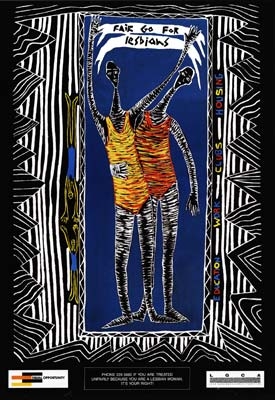
Gay Rights Page 2
Countering Discrimination
Removal of the crime of buggery from the statutes did not address the many other areas of law that continued to permit discrimination against gay men, lesbians and transgender people. It was not until August 1984 that the Bannon government introduced Anti-Discrimination legislation outlawing discrimination on the grounds of sex, sexuality, marital status, pregnancy, race or physical impairment. The sexuality clauses caused considerable discussion during the second reading debate, and, although the opposition opposed the inclusion of sexuality in the legislation, the legislation passed.
Transgender Law Reform
The transgender community has long been paradoxically both visible and invisible, due to the indeterminate nature of its makeup. Where the theatre has long provided 'acceptable' examples of cross dressing, transgender behaviours elsewhere have been seen as aberrant, attracting legal and medical attention.
As with the Gay and Lesbian rights movement, transgender people were not openly organized until the early 1970s, when the Seahorse Club established branches in most Australian capital cities. In May 1985 some South Australian members of Seahorse formed the Carrousel Club specifically to provide social and peer support to transgender people.
In December 1987, the Attorney General, the Hon. Chris Sumner, introduced the Sexual Reassignment Bill, making South Australia the first state to regulate the performance of reassignment procedures, and provide for the legal recognition of the reassigned sexual identity. The Bill underwent considerable amendment, with discussion of the value of sex change operations, and concern that amended birth certificates should continue to record the previous sexual identity
In 1994 a group of transgender people, with the support of a local treating psychiatrist established South Australian Transsexual Support (SATS) to provide information and support to people seeking sex reassignment surgery.
Carrousel continues to provide support to transgender people in South Australia.
Coming Out in S.A. 1879 - 1960
The social history of same sex attracted and transgender people is not so easy to discover. Until the 1970s most same sex attracted and transgender people hid their sexuality and gender identity in order to avoid discrimination and criminal penalties. The researcher must often rely on the records of trials of gay men, or seek evidence such as domestic living arrangements that may suggest a relationship. Sexuality defining terms such as homosexual, lesbian or transsexual, were not used before the early twentieth century, the concept of physical love between women being ignored by authorities as barely comprehensible, and transsexuality was mostly unknown before 1952, when American, Christine Jorgenson, had sex change surgery in Copenhagen.
Reports of the suicides of Ernest Neville and John Adamson at Gawler in 1879 provide an example of a tragedy that suggests an intimate relationship. "Both men were about thirty years of age, and bachelors, were deeply attached to each other, and in talking would always speak of each other as 'chummy', and have been keeping house together for a number of years".(Illustrated Adelaide News, November 1879) Conclusive evidence of the nature of their relationship, and those of men and women in similar situations, do not exist.
The prosecution of Adelaide City Councillor, Member of Parliament and probably best known gay man of the period, Bert Edwards, provides one of the city's most infamous crime cases. Arrested for sodomy in 1930, he was found guilty and sentenced to five years with hard labour, after a trial that lasted 8 days and attracted considerable public interest in February 1931. Edwards had been much loved in Adelaide's West End and had a reputation as a philanthropist, with numerous stories existing of his efforts to alleviate the conditions of the poor and disadvantaged. He was released on probation on 8 June 1933 and although expelled from the ALP in 1938, he was re-elected to the Adelaide City Council in 1948 remaining until his death in 1963. His obituary in The Advertiser said he was "well known for his charitable work among the needy of Adelaide's West End" where his name was "legend", that the "Nuns of the Daughters of Charity named a new dining hall after him" and the Premier, Sir Thomas Playford said, "Scarcely a good cause in the city did not receive some help from him." No mention was made of his conviction.
Items 13 - 24 of 44















